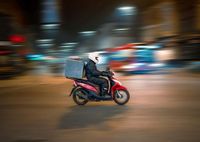The global appetite for food delivery services is as diverse as the cuisines people order. Data from YouGov Custom Surveys conducted from October 18 to 30, 2024, reveals fascinating variations across 17 countries in how frequently residents order pre-prepared meals through delivery platforms such as UberEats and Deliveroo. In this piece, we focus on two frequencies of food delivery – those who order at least once a week and those who do so at least once a month.
On this basis, the UAE leads by a good margin. The UAE, in particular, has the highest percentage of people ordering food delivery at least once a week (55%) and at least once a month (84%). In other emerging markets, India (40% weekly, 73% monthly) and Mexico (34% weekly, 62% monthly) reflect growing reliance on delivery services. Factors like urbanization, expanding middle-class consumer bases, and affordable delivery pricing may play a pivotal role.
The countries from the Asia-Pacific region in our list of 17 exhibit a mix of high engagement in Hong Kong (40% weekly, 66% monthly) and moderate levels in Indonesia (33% weekly, 55% monthly) and Singapore (26% weekly, 51% monthly). Advanced economies like Canada (19% weekly, 37% monthly), Germany (16% weekly, 40% monthly), and the US (15% weekly, 28% monthly), Great Britain (14% weekly, 37% monthly) display relatively lower levels of ordering appetite on a weekly and monthly basis. Sweden (10% weekly) and Denmark (8% weekly) land at the bottom of the weekly ordering list. Among markets that say they order food at least once a month, the US ranks the lowest at 28%. France (13%), Italy (13%), and Poland (12%) rank low as well in terms of weekly food ordering.
Ordering in once a week? Which service customers prefer the most? The weekly use of food delivery platforms across countries reveals striking differences in preferences. In the United States, UberEats and DoorDash hold a presence with 6% of respondents indicating weekly usage for each of them. GrubHub, Seamless, and Postmates each account for 2-4%. Mexico has a strong preference for UberEats at 24%, followed by "Other" services at 16%.
In Europe, UberEats logs sizeable weekly usage numbers in Germany (9%), France (10%), and Italy (3%). JustEat is used by customers to order in food at least once a week by 7% of those polled in the UK and 9% in France, while Deliveroo has a notable share of weekly users among the French (9%), Italians (4%), and Britons (5%). The UAE sees Talabat leading at 41%, followed by Noon Food (34%) and Careem (24%). India’s market is dominated by local giants, with Zomato at 36% and Swiggy at 35%. In Australia, UberEats (20%), DoorDash (16%), Deliveroo (16%), Menulog (14%), and Easi (12%) appear popular to order food in at least once a week.
Asian markets have distinct preferences, with Hong Kong favoring Deliveroo (35%), FoodPanda (34%), and KeeTa (33%), while Singapore is led by GrabFood (17%) and FoodPanda (13%).
Ordering in once a month? Which service customers prefer the most? Food delivery habits vary across countries, with different services being more frequently used in each market. In the UK, 22% of respondents report using JustEat at least once a month, while 18% use UberEats and 15% opt for Deliveroo. In Germany, nearly three in ten respondents (27%) order from Lieferando monthly, 14% from UberEats and 13% from Wolt.
In France, UberEats leads with 20% of respondents ordering monthly, followed by Deliveroo at 17% and JustEat at 13%. Italy sees an equal preference for Deliveroo (17%), JustEat (17%), and Glovo (16%) for ordering in food at least once a month. In the US, food delivery choices are spread across multiple platforms, with 17% opting for DoorDash, 14% of respondents using UberEats monthly, and 10% choosing GrubHub. Smaller segments of American respondents also order from Postmates (4%) and Seamless (3%).
In Mexico, monthly food delivery is significantly more common, with 50% of respondents using UberEats, 13% ordering from Deliveroo, and a significant 36% choosing the "other" category. The UAE has some of the highest reported food delivery usage, with 73% of respondents ordering from Talabat monthly, 62% from Noon Food, and 43% from Careem. In India, 72% of respondents order from Zomato at least once a month, while 66% do so from Swiggy. Australia also has a high rate of food delivery, with 37% of respondents using UberEats, 28% relying on DoorDash, 25% on Menulog, and 18% on Easi.
In Indonesia, nearly half of the respondents (47%) order from GoFood at least once a month, while 40% use GrabFood and 37% rely on ShopeeFood. In Singapore, GrabFood (41%) and FoodPanda (32%) are the most commonly used services. In Hong Kong, FoodPanda is the most preferred platform, with 57% of respondents ordering monthly, while in Canada, UberEats (25%), DoorDash (20%), and Skip the Dishes (20%) are the most frequently used.
Smaller or regional players account for a sizeable share of food delivery habits in various markets, with 5% to 36% of respondents in different regions reporting usage of platforms other than the ones listed in the survey option set. This data reflects how food delivery has become an ingrained habit in many parts of the world, with preferences shaped by regional availability and consumer convenience.
Careem reports key customer trends during Ramadan, highlighting shifts in grocery delivery, food ordering, donations, rides, cross-border payments, and dining out. Careem Food saw a surge in demand, with order volumes rising by 36% during Suhoor hours in March compared to February. The most frequently ordered Suhoor items were The Big Feast from McDonald’s and Plain Paratha from Punjab Flower Restaurant.
For Iftar, top choices included the eight-piece Wings Meal from Wingstop in Dubai and Special Haleem from Ritaj Restaurant in Abu Dhabi. The largest single Careem Food order in Dubai was valued at over AED2,460 ($670) for 10 items from Café Bateel, while the most expensive order in Abu Dhabi reached AED1,410 ($384) for 12 items from Behrouz Biryani.
Careem’s in-app donations service, Right Click, saw a 240% spike in total donations to local NGOs and charities across the UAE, KSA, and Jordan throughout Ramadan compared to February. Careem Pay, the digital payments and remittance service within Careem, recorded a 6% increase in international transfers during Ramadan, led by a 10% growth in transfers to India. Several customers reached the monthly transfer cap of AED450,000 ($122,600) via the India corridor, likely due to increased gifting and donations during the month.
One customer sent 46 separate transfers to Pakistan during Ramadan, and Pakistan saw the largest month-on-month increase in transfer volumes. Careem DineOut, the in-app dining discovery and booking service, was a popular choice for Iftar and Suhoor bookings this year. The most booked venues in Dubai included QD’s lounge and restaurant at Dubai Creek Resort, Lulu & The Beanstalk in DIFC, and Wagamama at Dubai Hills Mall, while diners in Abu Dhabi favoured Tuk Tuk Restaurant in Khalifa City, Pho 7, and The Irish Vickers.
The highest single saving recorded on Careem DineOut during Ramadan was AED6,760 ($1,841) on a booking valued at over AED27,000 ($7,350) at the Terrace Iftar at JW Marriott Marquis. One customer booked through Careem DineOut 31 times during the month, making them the most active foodie of Ramadan.
Careem Groceries also saw increased activity during the Holy Month, with orders placed around Iftar rising by 25%, and Suhoor orders surging by 70%. Overall grocery order volumes rose 8% in March compared to February, with the largest single grocery order in Dubai valued at more than AED2,800 ($762) for 60 items, while the biggest order in Abu Dhabi exceeded AED1,400 ($381) for 42 items.
The fastest grocery delivery in Dubai was completed in just 1.5 minutes to Al Safa Park Complex, with Abu Dhabi close behind at 2 minutes to Najmat Tower on Al Reem Island. Careem Rides saw that the busiest time in the UAE during Ramadan was around 3pm, likely due to shorter office hours and customers booking their preferred car types for their daily commutes.
Popular destinations in Dubai included Business Bay, Dubai Mall, and The Palm, while in Abu Dhabi, popular spots included Downtown and Hudariyat.



